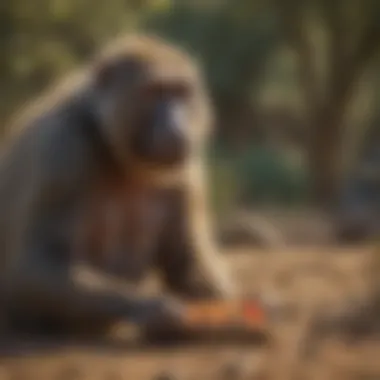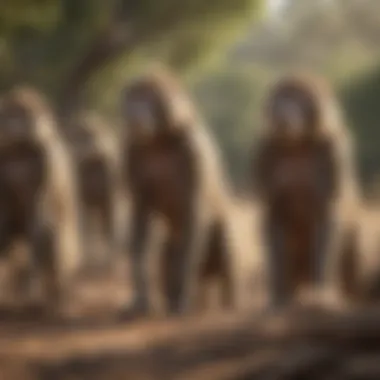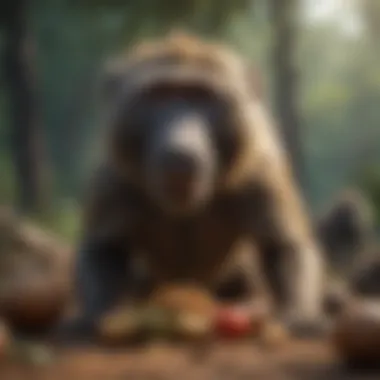Unveiling the Fascinating Dietary Patterns of Baboons in the Wild


Animal Species Profile
Baboons are fascinating primates known for their complex dietary habits and social behaviors. These intelligent creatures belong to the genus Papio and are found in various habitats across Africa and the Arabian Peninsula. Baboons are characterized by their dog-like snouts, powerful builds, and distinctive long, downward-curving tails. Their fur can range from olive-green and yellow to brown and black, providing effective camouflage in their natural environments.
Baboons typically dwell in savannas, grasslands, and rocky areas, displaying a remarkable adaptability to different landscapes. They are highly social animals, forming intricate hierarchies within troops led by dominant males. Communication among baboons involves a combination of vocalizations, facial expressions, and body language, allowing for complex interactions and social bonds.
Conservation & Wildlife Efforts
While baboon populations are currently stable overall, they face various threats in the wild, including habitat loss, human-wildlife conflict, and poaching. Conservation efforts aim to protect baboons and their habitats through sustainable resource management, community education, and anti-poaching measures. Organizations such as the Baboon Conservation Society work tirelessly to safeguard these primates and raise awareness about the importance of coexisting with wildlife.
One success story in baboon conservation involves the rehabilitation of orphaned or injured individuals back into the wild. By providing medical care, rehabilitation, and eventual release into suitable habitats, conservationists ensure the survival and well-being of individual baboons while contributing to the overall population's genetic diversity.
Animal Behavior & Psychology
Baboons exhibit a wide range of behaviors and cognitive abilities that reflect their complex social structures. Communication plays a crucial role in their interactions, with vocalizations conveying warnings, greetings, and territorial claims. Reproductive behavior in baboons involves intricate rituals and mating displays, with dominant males monopolizing access to females during estrus.
Studies have shown that baboons possess strong problem-solving skills, using tools and creative strategies to access food sources and overcome obstacles. Their intelligence extends to emotional awareness and social relationships, as evidenced by their ability to form alliances, show empathy, and exhibit cooperative behaviors within their troops.
Unique Facts & Trivia
Beyond their well-documented behaviors, baboons also display intriguing quirks and adaptations that set them apart from other primates. For instance, baboons have specialized cheek pouches that allow them to store food for later consumption, enabling efficient foraging and resource management. These primates are also proficient climbers, utilizing their dexterous hands and feet to navigate trees and rocky terrain with ease.
In terms of record-breaking feats, baboons are known for their agility and speed, capable of reaching impressive heights and distances through agile leaps and bounds. Their keen senses, sharp reflexes, and muscular builds contribute to their exceptional athletic feats in the wild.
Pet Care & Tips
While baboons are not suitable as pets due to their wild nature and specialized care requirements, prospective pet owners can learn valuable lessons from studying these primates. Understanding the social dynamics, dietary needs, and environmental enrichment of baboons can offer insights into providing optimal care for domesticated animals, such as primates kept in sanctuaries or zoos.
By emphasizing ethical considerations, species-appropriate diets, and mental stimulation for captive primates, individuals can contribute to the well-being and quality of life for all primates in human care. Training techniques based on positive reinforcement, behavioral observation, and environmental enrichment strategies can enhance the physical and psychological health of primates under human supervision.
Introduction
Understanding Baboons
Baboons, a diverse group of primates belonging to the genus Papio, exhibit various species-specific behaviors and adaptations that are crucial for their survival. When considering the overview of baboon species, one cannot ignore the significant roles they play in their respective habitats. Each baboon species has distinct characteristics and behaviors that contribute uniquely to the genetic diversity and behavioral repertoire of these primates. Understanding the nuances of each baboon species is vital in comprehending the broader context of baboon dietary habits.
In addition to their individual characteristics, the significance of baboons in the ecosystem cannot be overstated. Baboons play pivotal roles as seed dispersers, influencing plant diversity and ecosystem regeneration. Their foraging activities impact plant populations, ultimately shaping the dynamics of their habitat. Recognizing how baboons function within the ecosystem offers valuable insights into the interconnectedness of species and the importance of preserving these intricate relationships.
Anatomy and Physiology


In this section, we delve into the fascinating realm of baboons' anatomy and physiology, uncovering the intricate details that shape their dietary habits. The anatomical and physiological features of baboons play a crucial role in understanding their feeding behaviors and nutritional requirements. From their musculoskeletal structure to metabolic processes, every aspect contributes to their adaptation to diverse habitats and diets.
Dental Adaptations
Functional Aspects of Baboon Teeth
Baboon teeth exhibit fascinating functional aspects that are tailored to their dietary needs. The specialized dentition of baboons, including sharp incisors and robust molars, enables them to efficiently process various types of food. These adaptations allow baboons to consume a wide range of plant materials, including hard seeds and tough foliage, with ease. The impressive strength and sharpness of their teeth are essential for grinding and breaking down fibrous plant matter, highlighting the evolutionary significance of their dental structures.
Relationship to Diet
The relationship between baboon teeth and their diet is a critical aspect of their feeding behavior. The adaptation of their teeth directly influences the type of foods they can consume and digest effectively. The structured alignment of their teeth, coupled with their powerful jaws, enables baboons to tackle different food textures, from crunchy nuts to chewy fruits. This dental relationship to diet showcases the evolutionary efficiency of baboons in utilizing various food sources available in their habitats. While these dental adaptations are advantageous for their herbivorous tendencies, they also influence their occasional carnivorous inclinations, showcasing the versatility of baboons in adapting to shifting dietary requirements.
Foraging Behavior
When delving into the dietary habits of baboons, understanding their foraging behavior becomes essential. Foraging behavior encompasses the strategic methods employed by baboons to locate, obtain, and consume food sources in their natural habitat. Baboons exhibit intricate foraging patterns that reflect their dietary requirements and environmental adaptations. By observing their foraging behavior, researchers can glean valuable insights into the nutritional needs and feeding preferences of these fascinating primates.
Group Dynamics
Social Hierarchy Influences
The social hierarchy among baboons plays a significant role in shaping their foraging behavior and group interactions. Within a baboon troop, social hierarchy influences the distribution of resources, access to mates, and overall group cohesion. Baboons establish dominance through social interactions, with higher-ranking individuals enjoying priority in resource allocation. This hierarchical structure not only affects feeding opportunities but also regulates conflict resolution and social organization within the troop. The dominance hierarchy in baboon groups is maintained through various behaviors, including aggressive displays, grooming rituals, and submission gestures. Understanding the nuances of social hierarchy influences provides valuable insights into the dynamics of baboon communities and their foraging strategies.
Cooperative Foraging Strategies
Cooperative foraging strategies are prevalent among baboon groups, contributing to their overall foraging success and group cohesion. Baboons engage in cooperative behaviors to enhance their efficiency in locating and obtaining food sources, particularly in environments with varying food availability. Cooperative foraging allows baboons to exploit resources more effectively, reduce competition within the group, and improve overall foraging outcomes. Additionally, cooperative behaviors strengthen social bonds, foster reciprocity, and promote group stability. By coordinating their efforts in foraging activities, baboons showcase remarkable teamwork and communication skills that enhance their adaptive capabilities in challenging environments. Cooperative foraging strategies highlight the adaptive nature of baboons and underscore the importance of social relationships in their foraging success.
Dietary Composition
Baboons' dietary composition plays a crucial role in understanding their nutritional needs and foraging habits. Examining the dietary composition provides valuable insights into the diverse food sources that baboons rely on for survival. By exploring their plant-based diet, insect consumption, and occasional meat-eating behavior, we can decipher the intricacies of their food choices and feeding patterns.
Plant-Based Diet
Preference for fruits and seeds
The preference for fruits and seeds among baboons is a significant aspect of their plant-based diet. Fruits and seeds are rich in essential nutrients, vitamins, and minerals, contributing to the overall health and sustenance of baboon populations. This preference reflects their natural inclination towards nutrient-dense foods that support their energy requirements and dietary needs. While fruits provide sugars for quick energy, seeds offer a good source of fats and proteins, showcasing the balanced approach baboons have towards their dietary preferences.
Role of leaves and flowers
In addition to fruits and seeds, leaves and flowers also play a crucial role in the baboons' diet. These plant materials offer fiber, antioxidants, and micronutrients essential for digestive health and overall well-being. Baboons exhibit a selective grazing behavior when consuming leaves and flowers, indicating a strategic approach to their plant-based diet. Despite not being as calorically dense as fruits and seeds, leaves and flowers provide vital nutrients that contribute to the overall nutritional balance of baboons' diets.


Insect Consumption
Utilization of insects for protein
The utilization of insects for protein intake is a notable aspect of baboons' dietary habits. Insects serve as an essential source of high-quality protein, aiding in muscle maintenance and growth for baboons. Their ability to extract proteins from insects showcases their adaptive foraging behavior and efficient utilization of diverse food sources. Incorporating insects into their diet enhances the overall nutritional profile of baboons, demonstrating their adaptability to varying food sources in their environment.
Feeding patterns on insects
Baboons exhibit specific feeding patterns when consuming insects, showcasing specialized foraging techniques to procure this protein-rich food source. Their methodical approach to insect consumption involves meticulous inspection of surroundings, strategic hunting strategies, and targeted feeding behaviors. By incorporating insects into their diet, baboons supplement their protein intake, diversifying their nutrient sources and ensuring a well-rounded nutritional balance within their dietary habits.
Meat-Eating Behavior
Occasional carnivorous tendencies
Despite being primarily herbivorous, baboons display occasional carnivorous tendencies, engaging in meat-eating behavior opportunistically. These tendencies may arise from nutritional requirements, social dynamics, or environmental factors that drive baboons to consume meat. By occasionally incorporating meat into their diet, baboons obtain essential nutrients such as fats, vitamins, and minerals that may be lacking in their plant-based food sources.
Hunting and scavenging behaviors
When exhibiting meat-eating behavior, baboons showcase distinct hunting and scavenging behaviors that vary based on the availability of prey and competition within the group. Hunting behaviors involve coordinated strategies, stealth approaches, and group coordination to capture prey effectively. In contrast, scavenging behaviors capitalize on leftover carcasses or opportunities to steal kills from other predators, showcasing the adaptive nature of baboons' meat-eating habits.
Nutritional Requirements
The section on Nutritional Requirements in the article delves deep into the essential elements governing the dietary needs of baboons. Understanding the nutritional requirements of these primates is crucial in comprehending their foraging patterns, preferred food sources, and overall survival strategies. Analyzing the nutritional components necessary for baboons offers valuable insights into their ecological roles and how they adapt to various ecosystems. By exploring the intricacies of their nutritional requirements, we can uncover the factors shaping their dietary habits and energy demands.
Energy Needs
Caloric intake variations
Addressing the caloric intake variations in baboons is essential to grasp the dynamics of their energy needs. The fluctuation in caloric intake plays a pivotal role in adapting to seasonal variations in food availability and overall energy expenditure. Baboons exhibit varying caloric requirements based on factors like age, sex, reproductive status, and environmental conditions. Understanding the nuances of caloric intake variations sheds light on how baboons optimize their diet to meet energy demands efficiently, ensuring survival and reproductive success.
Highlighting the significance of caloric intake variations in baboons elucidates the adaptive strategies employed to ensure energy balance and sustenance. The ability to adjust caloric intake based on nutritional requirements reflects the adaptive flexibility of baboons in different ecological settings. By examining the unique characteristics of caloric intake variations, we can appreciate the evolutionary advantages it provides in ensuring the fitness and resilience of baboon populations.
Factors influencing energy demands
Exploring the factors that influence energy demands in baboons uncovers the intricate interplay between environmental, physiological, and behavioral aspects. Various factors such as competition for resources, daily activity patterns, metabolic rates, and social hierarchies significantly impact the energy needs of baboons. Understanding how these factors shape energy demands offers a holistic view of the challenges and opportunities in sustaining baboon populations.
The key characteristic of factors influencing energy demands lies in its multifaceted nature, where individual and group dynamics interact to determine the optimal energy allocation for survival and reproduction. By delving into the unique features of energy demand influencers, we gain valuable insights into the adaptive strategies baboons employ to navigate complex ecosystems. Recognizing both the advantages and disadvantages of these influencing factors enhances our understanding of the intricate balance between energy expenditure and acquisition in baboons.
Environmental Influences


Seasonal Changes
Impact on Food Availability
In the realm of baboons' dietary habits, seasonal changes wield a significant influence on food availability. The fluctuation in fruiting seasons, plant growth patterns, and insect abundance directly impacts the nutritional resources accessible to baboons. This variation in food availability prompts baboons to employ adaptive strategies to meet their dietary needs efficiently. The adaptability of baboons to these changes showcases their intuitive ability to navigate environmental challenges to ensure sustenance.
Dietary Adaptations
Baboons' dietary adaptations in response to seasonal changes underscore their evolutionary resilience. These adaptations encompass a spectrum of behaviors, from adjusting foraging locations to diversifying food preferences based on availability. By exploring how baboons modify their dietary choices in tandem with seasonal shifts, a deeper understanding of their foraging strategies emerges. This insightful exploration sheds light on the resourcefulness and versatility displayed by baboons in the face of changing environmental conditions.
Habitat Factors
Effects of Habitat Degradation
The adverse effects of habitat degradation pose significant challenges to baboons' dietary habits. As human encroachment and deforestation encroach on baboons' habitats, the availability of food sources diminishes. The implications of habitat degradation reverberate through the baboon population, exerting pressure on their foraging abilities. Understanding the repercussions of habitat loss on baboons' nutrition unveils the urgent need for conservation efforts to mitigate these detrimental effects.
Nutritional Challenges
Navigating nutritional challenges amidst habitat degradation emerges as a critical aspect of baboons' survival strategies. The scarcity of resources, coupled with the competition for food within a shrinking habitat, poses nutritional hurdles for baboons. By delving into the nutritional challenges they face, insights into the complexities of maintaining a balanced diet in a compromised environment surface. Examining how baboons overcome these challenges underscores the resilience and adaptability ingrained in their dietary behaviors.
Conservation Implications
In this segment devoted to Conservation Implications, we delve into the critical aspect of preserving the delicate ecosystem where baboons thrive. Understanding the impact of human-wildlife conflicts on baboon populations is paramount in ensuring their survival. Conservation efforts play a pivotal role in safeguarding these fascinating creatures and maintaining a sustainable environment for all species involved.
Human-Wildlife Conflict
Impact on Baboon Diet
Within the realm of Human-Wildlife Conflict lies the specific concern of how human activities influence the dietary habits of baboons. The encroachment of human settlements often disrupts the natural foraging grounds of baboons, leading to alterations in their food sources. This shift can result in nutritional deficiencies or excesses that impact the overall health and well-being of baboon communities.
Strategies for Coexistence
Addressing the challenges of Human-Wildlife Conflict necessitates the implementation of effective strategies for coexistence. By developing sustainable practices that mitigate conflicts between humans and baboons, we can promote harmonious living arrangements for both parties. Encouraging habitat protection, promoting responsible waste disposal, and implementing non-lethal deterrents are some of the tactics that can foster peaceful cohabitation and reduce negative interactions between humans and baboons.
Conclusion
Drilling down to decode the essence of baboons' dietary habits wraps up our exploration with a meticulous examination of crucial insights. In this final segment, we converge on highlighting the pivotal points encapsulated throughout this article. Understanding the dietary habits of baboons enlightens us on the intricate balance within their ecosystem. By dissecting their foraging nuances and nutritional requirements, we gain a profound comprehension of their survival strategies. Deciphering the baboons' dietary composition and foraging behavior unravels a tapestry of their evolutionary adaptations and ecological significance. This conclusive section underscores the paramount significance of delving into the complexities of baboons' dietary habits for a holistic view of their lives and habitats.
Key Takeaways
Insights into baboon dietary patterns
Bridging the gap between curiosity and comprehension, the segment on insights into baboon dietary patterns offers a captivating register of their food preferences and consumption behaviors. The focal point elucidates the fine line between plant-based diets, insect consumption, and sporadic meat-eating tendencies within the baboon community. As we delve deeper, the nuanced preferences for fruits and seeds, coupled with the utilization of insects for protein needs, paint a vivid picture of their dietary diversity. This detailed analysis not only sheds light on their nutritional balance but also underscores the adaptability of baboons in optimizing resource utilization for sustained survival across habitats. Unveiling the layers of insights into baboon dietary patterns unravels a dynamic interplay of biological imperatives and environmental exigencies, enriching our understanding of their dietary ecology.
Implications for conservation efforts
Navigating the terrain of conservation, the discourse on implications for conservation efforts elucidates the ripple effects of human interventions on baboon dietary dynamics. By extrapolating the repercussions of habitat degradation and human-wildlife conflicts on their dietary patterns, a stark juxtaposition emerges between natural foraging behaviors and anthropogenic impositions. Recognizing the intrinsic link between baboons' dietary habits and conservation imperatives, strategic frameworks for fostering human-baboon coexistence emerge as a beacon of hope. Analysing the proactive measures aimed at mitigating human-wildlife conflicts and safeguarding critical habitats unveils a roadmap towards harmonious conservation practices. Diving into the realm of implications for conservation efforts not only underscores the urgency of preserving baboons' dietary resources but also underscores our ethical responsibility towards ensuring their ecological sustainability.







